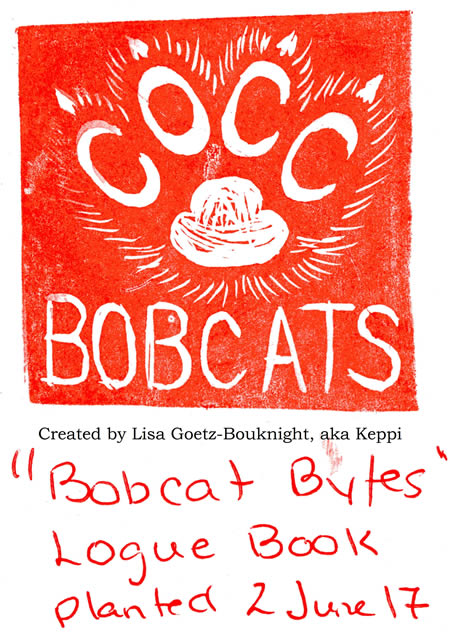Hide and Seek for Writing Students - A Letterbox View of COCC
By Jon Bouknight
Through the work of spring Writing (WR) 65 students and Lisa Goetz-Bouknight, their teacher, COCC is now on the map (literally!) in the letterboxing community. Letterboxing, a hobby for those who like hiking and searching in public spaces, takes its fans all over the world as they follow instructions to find hidden images and leave messages. Finding a letterbox allows the searcher to record the discovery with its unique stamp, often hand-carved; then the searcher uses her or his personal stamp and trail name to leave a record in the letterbox's log-book, kept alongside the stamp.
Now letterbox searchers are coming to COCC's Bend campus as they seek six hidden caches of stamps and log-books that were created by Goetz-Bouknight and her students as part of her multi-modal assignment in writing. Multi-modal writing, a current trend in composition instruction, encourages students to consider different audiences and forms of media as they choose their writing purpose and strategies. "All writers struggle to connect to a reader, to have a reader see his or her perspective," says Goetz-Bouknight, whose assignment requires that students compose engaging titles and historical descriptions of the campus as well as instructions that take searchers on a scenic path, culminating in a hidden surprise. The students also provided icons evocative of their assigned locations that Goetz-Bouknight incorporated into the stamps in each letterbox. The unfamiliarity of this hobby and the multi-modal aspects of this assignment offer a fresh start for all writing students: "Because writers could use puzzles and cryptography, [the assignment] bridged a gap between native and non-native speakers." Goetz-Bouknight also thought that letterboxing might "give students an activity they could do with their families, an activity that is affordable, accessible, multi-generational."
Goetz-Bouknight's students started learning about the assignment by reading examples of already existing instructions, usually a series of clues, culled from the website AtlasQuest—a major internet portal for this hobby. Testing the feasibility of her own assignment, Goetz-Bouknight modeled the project by giving the students instructions to find her letterbox and stamp entitled "Bobcat Bytes." As they planned their own clues, students could experience the audience role by searching for "Bobcat Bytes," which Goetz-Bouknight had already hidden, or "planted."
Although search instructions are often written in poetic or playful ways, Goetz-Bouknight also requires her students to build instructions around a class theme as well as the location where the letterbox would be hidden. "I assigned areas," Goetz-Bouknight said, "based on the Campus Walking Tour Map, so students had easily available information and the activity could complement already existing art installations, memorial plaques—capturing the people and places of the campus." Working in pairs, the WR65 students explored and researched their assigned locations; they, then, applied the concept of "sanctuary" –the class' unifying theme. In short, each team developed a path that explored the assigned area, then composed a title, historical overview and instructions to find the letterbox and created the image for the enclosed stamp. The four modes of expression in this project capture students' knowledge of the assigned theme and areas. Notable features of our institution are evoked by the names that the WR65 students chose, such as "La Biblioteca de Barber" or "Food for your Soul." Other names from the class, such as "Spiraling up the Y-axis" or "B the Journey," promise clues that will challenge searchers' problem solving skills.
Once all teams had finished planting the letterboxes and refining their search instructions, they took on new roles, reading and following the other teams' instructions. To help the new searchers leave unique images and trail names in the log-books, Goetz-Bouknight supplied all her WR65 students with ink-pads and individual stamps. In this last phase of the project, they could test each other's work, finding the hiding spot and stamping the log-book in their classmates' letterboxes. As Goetz-Bouknight had anticipated, searchers often got lost right in front of the teams who wrote the instructions and who "struggled to find the faults in their own writing." The challenges of the search helped students better understand the audience's needs. According to Goetz-Bouknight, "Weak writers got to see their strengths, and strong writers had to confront their weaknesses."
The peripatetic assignment has had no negative impact on the campus environment. After letterboxing was originally conceived in Britain in 1854 (according to AtlasQuest), practitioners soon learned that the hiding and searching required a code of ethics if the hobby was to continue. The letterbox code insists that planters and seekers do not harm the natural or historic significance of any area, and they prohibit building structures or altering the landscape. In addition to those standards, Goetz-Bouknight obtained permission from Campus administrators before undertaking the project with her students.
As she had promised, Goetz-Bouknight uploaded the students' titles and instructions to the internet after the class had ended, making them available to all letterbox searchers. Some of these searchers, in addition to maintaining hand-written and stamped log-books, provide online comments about the experience of searching and finding (or not) a given letterbox. Already the students' series of six letterboxes across the Bend campus have garnered a happy review from "Pappasky" posted in August: "This is a challenging series!! All of the clues are written by different people and each of them unique in their own perspective. . . . These are amongst the BEST boxes I have found and are AWESOME each in their own right. Go get them." Fans of letterboxing, like Pappasky, are adventurous, and they can now explore COCC's historic and empowering campus as they search for the letterboxes hidden by the WR65 class. For those who want to join them, the specific location for the series "COCC: A Sanctuary for Students" can be found at www.atlasquest.com.
Sources:
- Goetz-Bouknight, Lisa. Interview 9-19-17
- "History of Letterboxing" AtlasQuest. Accessed 9-18-17
- Pappasky August 2017. AtlasQuest. Accessed 9-20-17

